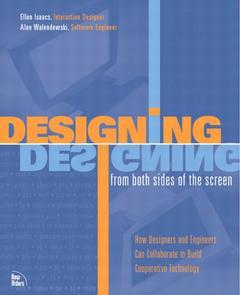Description
Designing from both sides of the screen
Authors: ISAACS Ellen, WALENDOWSKI Alan
Language: English
Subjects for Designing from both sides of the screen:
Approximative price 52.85 €
Subject to availability at the publisher.
Add to cart336 p. · 19x23 cm · Paperback
Description
/li>Contents
/li>
Design and build better software by understanding the motivations of your collaborators.
- Illustrates in a step-by-step manner the design processes and presents a practical, hands-on approach to the real world process of designing a user interface (UI).
- Offers clear principles and a proven design philosophy, which are easily incorporated into diverse design problems.
- Includes a metric to measure how well a design is enabling "flow", a concept described in the book.
Ellen Isaacs has been designing software user interfaces for over 11 years at such companies as Sun Microsystems, Excite@Home, AT&T and Electric Communities (now communities.com). She has designed applications for a variety of platforms including Windows, OpenWindows, the Web, and Palm OS.
Alan Walendowski has been a software engineer working in the trenches for over 15 years. He has worked for companies such as Sun Microsystems, 3DFX, AT&T, IBM, and ComputerVision. Walendowski has worked on device drivers, graphics engines, systems software, distributed systems, client-server systems, and user interfaces.
THE GOAL.
1. On Being a Butler.2. Dont Impose: Respect Physical Effort.
3. Dont Impose: Respect Mental Effort.
4. Be Helpful.
THE PROCESS.
5. Setting Up: Understanding Users Needs.
6. Structuring the User Interface.
7. Laying Out the User Interface.
8. Architecting with the UI in Mind
9. Initial Development.
10. Iterative Development: Observing Use.
11. Conclusion.
APPENDIXES.
Appendix A. Guidelines.
Appendix B. Recommended Readings.
Index.

